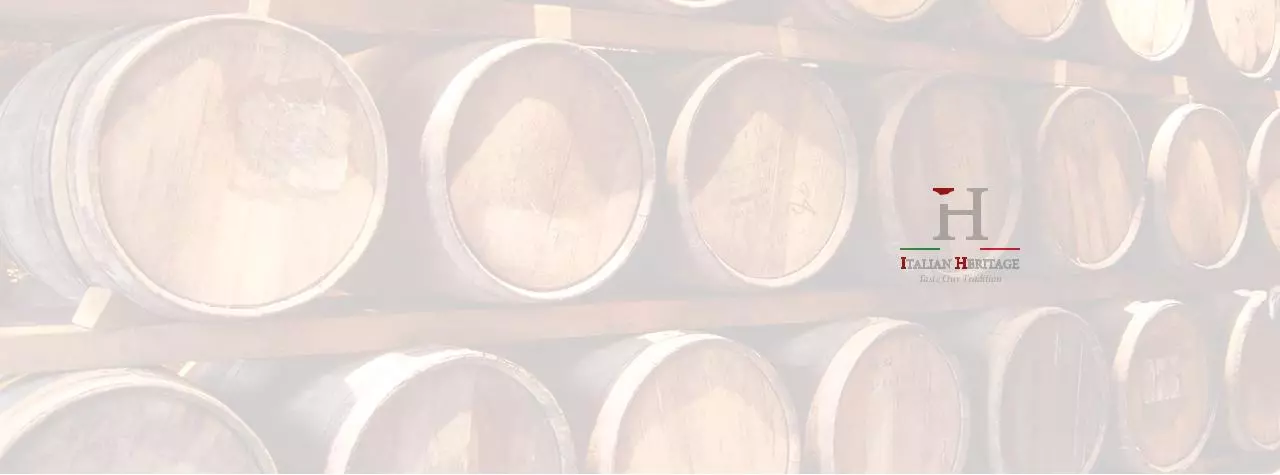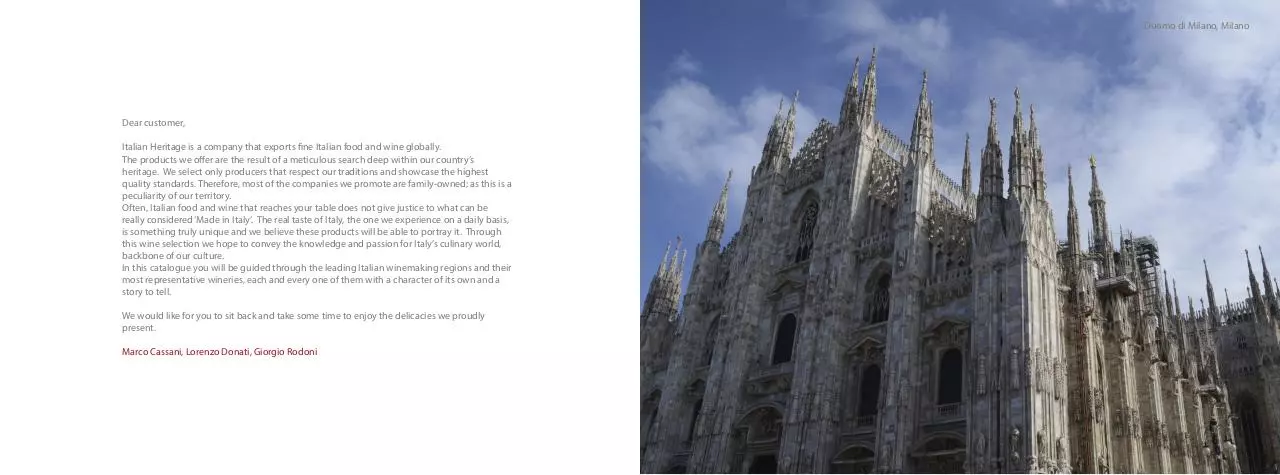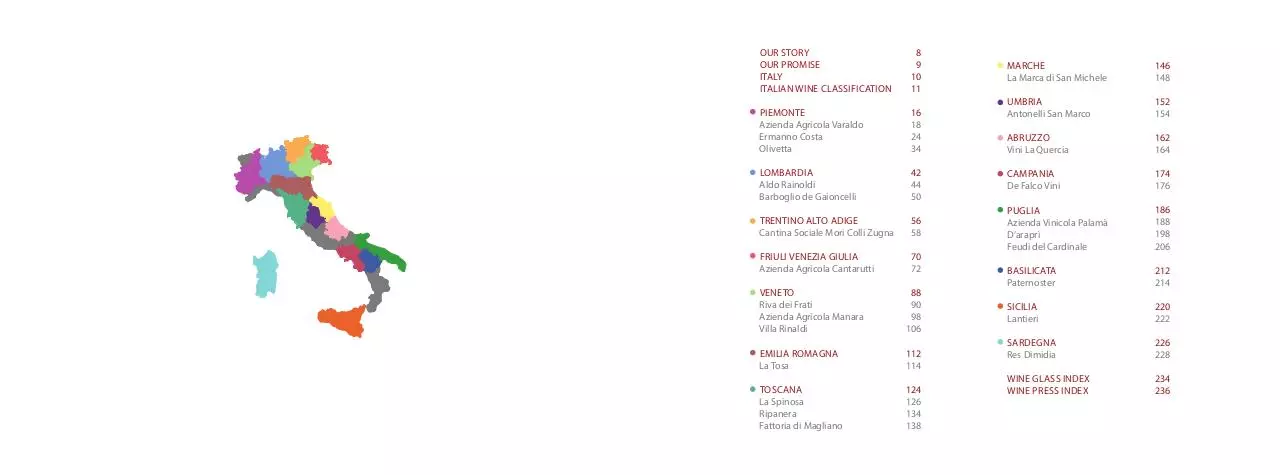Wine Selection 2015 digital (PDF)
File information
This PDF 1.4 document has been generated by Adobe InDesign CS6 (Macintosh) / Adobe PDF Library 10.0.1, and has been sent on pdf-archive.com on 20/03/2015 at 15:53, from IP address 95.142.x.x.
The current document download page has been viewed 534 times.
File size: 68.09 MB (121 pages).
Privacy: public file





File preview
ITALIAN HERITAGE
Taste Our Tradition
WINE SELECTION
2015
ITALIAN HERITAGE
Taste Our Tradition
Duomo di Milano, Milano
Dear customer,
Italian Heritage is a company that exports fine Italian food and wine globally.
The products we offer are the result of a meticulous search deep within our country’s
heritage. We select only producers that respect our traditions and showcase the highest
quality standards. Therefore, most of the companies we promote are family-owned; as this is a
peculiarity of our territory.
Often, Italian food and wine that reaches your table does not give justice to what can be
really considered ‘Made in Italy’. The real taste of Italy, the one we experience on a daily basis,
is something truly unique and we believe these products will be able to portray it. Through
this wine selection we hope to convey the knowledge and passion for Italy’s culinary world,
backbone of our culture.
In this catalogue you will be guided through the leading Italian winemaking regions and their
most representative wineries, each and every one of them with a character of its own and a
story to tell.
We would like for you to sit back and take some time to enjoy the delicacies we proudly
present.
Marco Cassani, Lorenzo Donati, Giorgio Rodoni
OUR STORY
OUR PROMISE
ITALY
ITALIAN WINE CLASSIFICATION
8
9
10
11
PIEMONTE
Azienda Agricola Varaldo
Ermanno Costa
Olivetta
16
18
24
34
LOMBARDIA
Aldo Rainoldi
Barboglio de Gaioncelli
MARCHE
La Marca di San Michele
146
148
UMBRIA
Antonelli San Marco
152
154
ABRUZZO
Vini La Quercia
162
164
42
44
50
CAMPANIA
De Falco Vini
174
176
TRENTINO ALTO ADIGE
Cantina Sociale Mori Colli Zugna
56
58
FRIULI VENEZIA GIULIA
Azienda Agricola Cantarutti
70
72
PUGLIA
Azienda Vinicola Palamà
D’araprì
Feudi del Cardinale
186
188
198
206
BASILICATA
Paternoster
212
214
SICILIA
Lantieri
220
222
SARDEGNA
Res Dimidia
226
228
WINE GLASS INDEX
WINE PRESS INDEX
234
236
VENETO
Riva dei Frati
Azienda Agricola Manara
Villa Rinaldi
88
90
98
106
EMILIA ROMAGNA
La Tosa
112
114
TOSCANA
La Spinosa
Ripanera
Fattoria di Magliano
124
126
134
138
OUR STORY
Italian Heritage was born by the intuition of three young Italian foodies and lifetime friends that enjoy the
culinary pleasures of the Italian tradition and are eager to export the true taste their country has to offer.
Throughout their constant travels and the time spent in London, during the university period, they noticed
the lack of products worthy of the authenticity and quality Italy can and should offer. Their international
mind-set pushed them to accomplish their dream and, after a few years experience in different work
environments, they decided to open Italian Heritage in order to reveal what lies behind Italy’s best kept
secrets.
Marco grew up bottling and labelling the wine his father, Sergio, produced for family and friends. He
always loved to visit his grandmother Angela, who used to run the family tavern, in order to taste his
favourite dishes from Lombardia. With a real devotion for finished products he likes to see how quality and
taste can be combined to design, another great attribute of his country.
Lorenzo loves to curiously browse around Italy to find the most peculiar products that combine both
tradition and innovation. Great beer, chocolate and cheese expert in his free time he likes to sit back and
enjoy these delicacies with his father Domenico, absolute food and wine enthusiast. His family history in
the culinary environment dates back to World War II where his grandfather, Primo, managed a fruit store.
With the desire to share his passion, he is the one responsible for the delivery of the products directly onto
your doorstep.
Giorgio, with a degree in biology, is truly passionate about vineyard cultivation as well as the different
winemaking processes employed. He inherited his passion for food and wine from his grandfather
Giuseppe, famous restaurateur, and his father Giancarlo, authentic wine lover and connoisseur. His blend
of Northern and Southern Italian roots make him the perfect expression and expertise of the variety and
quality different regions have to offer.
The name Italian Heritage was chosen because it relates to Italy’s patrimony. Each and every Italian
individual has a family heritage, made up of culinary customs and traditions that are handed down from
generation to generation. This is what makes Italian products unique, and what these entrepreneurs want
to convey. The name Italian Heritage embraces the vision, purpose and philosophy Giorgio, Marco, and
Lorenzo want to communicate.
OUR PROMISE
Food is our culture. We promise to provide you with 100% Italian products of the highest quality.
Our Quest is to search for and deliver you the most exclusive delicacies our country’s heritage has to offer.
Customer Care is a key ingredient of our philosophy. The objective is to ensure that customers are
satisfied with their purchase. We pay the highest of attention to the production and packaging process
of your goods as well as tracking and granting you a safe delivery of your shipment. We are committed to
implement a post sales service to be proud of.
The easier, the better. Italian Heritage offers groupage and logistic services, which allow you to import
different products throughout Italy in the most efficient manner. ...Many different products, one shipment,
one invoice...
Pleased to meet you. We guarantee to schedule business visits in your country on a regular basis, and you
will be able to recognize our brand during the frequent fairs in which we will exhibit.
We are here for you. Any particular product request? Just let us know and we will find it for you.
ITALIAN WINE CLASSIFICATION
ITALY
Italy has a rich vinicultural heritage dating back more than two thousand years.
Over the centuries Greeks, Etruscans and Romans all played a significant role in the development of
different wine styles, the way grapevines were grown, and the evolution of winemaking traditions.
There is no mistaking Italy on a map, with its long, boot-like shape. Famed for its huge diversity of terroirs,
grape varieties and wine styles Italy produces 51.5 million hL of wine per year. Italy is divided into 20 wine
regions and Italian wines are made with the aim of partnering Italy’s rich and varied cuisine.
Several factors have contributed to this success story, including the fact that Italy’s
vine-growing conditions are so favorable. This is not surprising, considering the abundance of
Mediterranean sunshine, moderated by cool, mountain air currents and sea breezes. There are also myriad
terrains, from Italy’s lengthy coastlines to foothills with slopes ideal for growing grapes.
The mountain ranges, such as the Italian Alps in the north and the Apennines running through the centre
of the country, provide high altitudes for cool-climate viticulture and help moderate the high temperatures.
Each zone also has its own macroclimate, resulting in significant variation in wine styles.
Italy offers a larger, more diverse array of wine styles than almost any other nation, most of which are
officially named, defined and protected under the Italian wine appellation system, which lists more than
330 DOCs, roughly 70 DOCGs and almost 120 IGTs. More than 2000 indigenous grape varieties are available
and Italian wines are recognized for their incomparable quality, variety and choice of aroma and flavor.
The golden rule for consumers in the wine business is to always have a close look at the label.
However, if we don’t know the terms, acronyms, symbols and units used even the more careful reader can
find himself lost in the Italian/European Union wine classifications.
This page is designed to help you understand with which spirit the appellations were intended, to protect
the final consumer from possible frauds and to guide your choice towards the best wine possible.
The wine classification is governed by regulations issued by the European Union. These are then translated
and adopted by national regulations. The classification desired by the European Union intends to divide the
wines in two basic types:
IGP (Protected Geographical Indication)/DOP (Protected Designation of Origin) are wines that maintain a
close correlation with the territory in which the grapes are grown, and are part of a winemaking process
more or less strictly regulated.
TABLE WINES (although this wording, framed by the old rules, is no longer legal since the European Union
acted to deregulate designations) are wines not necessarily related to specific grape varietals and/or
production areas defined and not bound by winemaking regulations.
However, the Italian legislation introduced some important variations to the European guidelines. For
instance, IGT (Typical Geographical Indication) was introduced in place of the IGP abbreviation and, the
DOC (Denomination of Controlled Origin) and DOGC (Denomination of Controlled and Guaranteed Origin)
was introduced in place of the DOP abbreviation.
All of the Italian Wine Classifications are as follows:
VINO (WINE) wines that belong to this category are produced from authorized grapes without
constraints linked to territoriality or grape varietal. There are no special requirements that regulate the
production, other than those linked to health and hygiene. The label must compulsorily bear the name
of the bottler and it may have an indication of the colour (i.e. Red Wine, White Wine or Rosè Wine) and
vintage. It is explicitly forbidden to refer to grape varietal used.
VINO VARIETALE (VARIETAL WINE) are wines produced using at least 85% of a specific grape varietal.
For this specific category the grape varietal can be indicated on the label, subject to it being an
international grape varietal (i.e. Cabernet, Cabernet Franc, Cabernet Sauvignon, Chardonnay, Merlot,
Sauvignon, Syrah). As, for the above category, the name of the bottler must be indicated on the label,
whilst the vintage year is not compulsory
IGT (Typical Geographical Indication) was introduced in 1992, to allow a certain level of freedom to
Italy’s winemakers. Prior to1992, many wines failed to qualify for DOC or DOCG status, not because they
were of
low quality, but because they were made from grape varieties (or blends) not sanctioned under DOC/G
laws. The IGT classification focuses on the region of origin, rather than grape varieties or wine styles (ex.
Toscana’s IGT Supertuscans).
DOC (Denomination of Controlled Origin) is the answer to the French AOC and is the main tier of Italian
wine classification. It covers almost every traditional Italian wine style. There are around 330 individual
DOC titles, each with a set of laws governing its viticultural zone, permitted grape varieties and wine
style, in order to preserve local traditions. Those which show consistently high quality (after 10 years)
earn promotion to DOCG status.
DOCG (Denomination of Controlled and Guaranteed Origin) is the highest classification for Italian
wines. It denotes controlled production methods and guaranteed wine quality. There are strict rules
governing the production of DOCG wines, most obviously the permitted grape varieties, yield limits,
grape ripeness, winemaking procedures and barrel/bottle aging. To guarantee quality every DOCG wine
is subject to official tasting/analysis procedures throughout the winemaking process.
In order to guarantee quality/traceability and t prevent counterfeiting the DOC and DOCG bottles have a
government seal across the neck. This seal has an alpha-numeric code that, if typed in the website of many
consortiums allows to check the bottler, the bottling date and other information. Above all, to make sure of
the authenticity of the brand.
DOC and DOCG wines are subject to other three sub-denominations.
Classico the word “Classic” or “Historical” (the latter reserved for sparkling wines) indicates that the wine
has been produced in a sub-area of a DOC or DOCG which can boast older and more prestigious roots
in comparison to the remaining territory. In order to be granted this title, special regulations in the
winemaking process may be required.
Riserva the qualification “Reserve “ is attributed to the DOC or DOCG wine that supported aging (including
refinement) longer than that provided by the disciplinary of at least: 2 years for red wines, 1 year for white
wines and sparkling wines obtained by the Martinotti/Charmat method, and 3 years for sparkling wines
obtained by the Metodo Classico procedure.
Superiore the specification “ Superior “ identifies DOC or DOCG wine for which a yield per hectare lower
by at least 10 % (compared to the requirements of the disciplinay) is establish. This is adopted in order to
improve the organoleptic qualities of the wine and raise the alcohol content of at least 0.5 % above the
reference standard.
WINE SELECTION 2015
PIEMONTE
Mole Antonelliana, Torino
Piemonte lies in the north-western corner of the Italian Peninsula, and its name means ‘the
foot of the mountains’. The Alps and Apennines are largely responsible for its favourable
climate. With 46 different DOC and four DOCG areas, Piemonte is the region that produces
the largest number of best known, noble, and world- appreciated (award-winning) wines.
Another distinguished characteristic of Piemonte is that most of its wines are produced
on family estates made up of relatively small parcels of land. The distinguished Nebbiolo
grapes are behind Italy’s finest reds and four of Piemonte’s DOCG titles: Barolo, Barbaresco,
Gattinara and Roero. Its name derives from the word nebbia, or fog, because of a velvety,
whitish coating over its berries in addition to the fact that it grows in an area where, at
ripening time in September, heavy morning fog and the humidity that it provides gives the
grapes an ideal habitat.
Barbera, Piemonte’s most widely planted red variety, from the Monferrato hills, is responsible
for growing a number of superlative wines, sold mostly as Barbera del Monferrato, Barbera
d’Asti or Barbera d’Alba. Barbera-based wines, although noticeably less tannic than their
Nebbiolo counterparts, are classically Italian: tangy reds with good acidity and aromas of
fresh plums and dark cherries. They are more enjoyable earlier on in their lives.
The third red grape of Piemonte is Dolcetto, (d’Alba, d’Acqui and di Ovada are the top three).
Although its name means ‘little sweet one’, Dolcetto is usually used to make dry red wines
with an appetizing, gently bitter finish. Although Piemonte is known as a red-wine region,
there are white wines that are becoming increasingly popular, such as the Roero Arneis a
delicate and refreshing dry white with an exotic perfume. Others include Moscato d’Asti and
Asti Spumante, both made from Moscato grapes as well as Gavi, the white made from local
variety Cortese.
Vineyards cover 57,487 hectares; yearly wine production is 3,405,000 hectolitres; 30% white,
70% red; 55.8% is DOC.
Download Wine Selection 2015 - digital
Wine Selection 2015 - digital.pdf (PDF, 68.09 MB)
Download PDF
Share this file on social networks
Link to this page
Permanent link
Use the permanent link to the download page to share your document on Facebook, Twitter, LinkedIn, or directly with a contact by e-Mail, Messenger, Whatsapp, Line..
Short link
Use the short link to share your document on Twitter or by text message (SMS)
HTML Code
Copy the following HTML code to share your document on a Website or Blog
QR Code to this page

This file has been shared publicly by a user of PDF Archive.
Document ID: 0000216325.